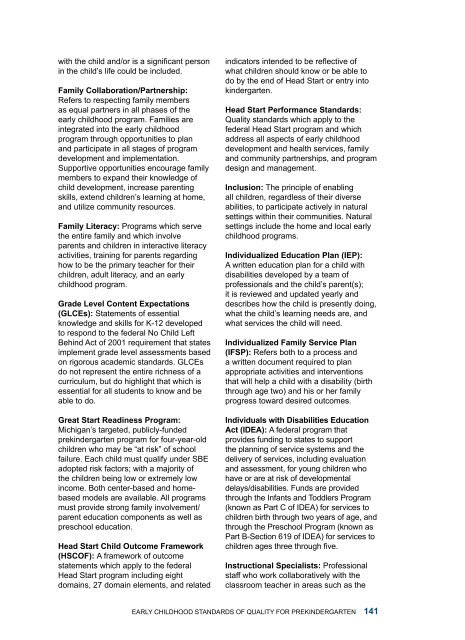Early Childhood Standards of Quality for ... - State of Michigan
Early Childhood Standards of Quality for ... - State of Michigan
Early Childhood Standards of Quality for ... - State of Michigan
You also want an ePaper? Increase the reach of your titles
YUMPU automatically turns print PDFs into web optimized ePapers that Google loves.
with the child and/or is a significant personin the child’s life could be included.Family Collaboration/Partnership:Refers to respecting family membersas equal partners in all phases <strong>of</strong> theearly childhood program. Families areintegrated into the early childhoodprogram through opportunities to planand participate in all stages <strong>of</strong> programdevelopment and implementation.Supportive opportunities encourage familymembers to expand their knowledge <strong>of</strong>child development, increase parentingskills, extend children’s learning at home,and utilize community resources.Family Literacy: Programs which servethe entire family and which involveparents and children in interactive literacyactivities, training <strong>for</strong> parents regardinghow to be the primary teacher <strong>for</strong> theirchildren, adult literacy, and an earlychildhood program.Grade Level Content Expectations(GLCEs): <strong>State</strong>ments <strong>of</strong> essentialknowledge and skills <strong>for</strong> K-12 developedto respond to the federal No Child LeftBehind Act <strong>of</strong> 2001 requirement that statesimplement grade level assessments basedon rigorous academic standards. GLCEsdo not represent the entire richness <strong>of</strong> acurriculum, but do highlight that which isessential <strong>for</strong> all students to know and beable to do.Great Start Readiness Program:<strong>Michigan</strong>’s targeted, publicly-fundedprekindergarten program <strong>for</strong> four-year-oldchildren who may be “at risk” <strong>of</strong> schoolfailure. Each child must qualify under SBEadopted risk factors; with a majority <strong>of</strong>the children being low or extremely lowincome. Both center-based and homebasedmodels are available. All programsmust provide strong family involvement/parent education components as well aspreschool education.Head Start Child Outcome Framework(HSCOF): A framework <strong>of</strong> outcomestatements which apply to the federalHead Start program including eightdomains, 27 domain elements, and relatedindicators intended to be reflective <strong>of</strong>what children should know or be able todo by the end <strong>of</strong> Head Start or entry intokindergarten.Head Start Per<strong>for</strong>mance <strong>Standards</strong>:<strong>Quality</strong> standards which apply to thefederal Head Start program and whichaddress all aspects <strong>of</strong> early childhooddevelopment and health services, familyand community partnerships, and programdesign and management.Inclusion: The principle <strong>of</strong> enablingall children, regardless <strong>of</strong> their diverseabilities, to participate actively in naturalsettings within their communities. Naturalsettings include the home and local earlychildhood programs.Individualized Education Plan (IEP):A written education plan <strong>for</strong> a child withdisabilities developed by a team <strong>of</strong>pr<strong>of</strong>essionals and the child’s parent(s);it is reviewed and updated yearly anddescribes how the child is presently doing,what the child’s learning needs are, andwhat services the child will need.Individualized Family Service Plan(IFSP): Refers both to a process anda written document required to planappropriate activities and interventionsthat will help a child with a disability (birththrough age two) and his or her familyprogress toward desired outcomes.Individuals with Disabilities EducationAct (IDEA): A federal program thatprovides funding to states to supportthe planning <strong>of</strong> service systems and thedelivery <strong>of</strong> services, including evaluationand assessment, <strong>for</strong> young children whohave or are at risk <strong>of</strong> developmentaldelays/disabilities. Funds are providedthrough the Infants and Toddlers Program(known as Part C <strong>of</strong> IDEA) <strong>for</strong> services tochildren birth through two years <strong>of</strong> age, andthrough the Preschool Program (known asPart B-Section 619 <strong>of</strong> IDEA) <strong>for</strong> services tochildren ages three through five.Instructional Specialists: Pr<strong>of</strong>essionalstaff who work collaboratively with theclassroom teacher in areas such as the<strong>Early</strong> <strong>Childhood</strong> <strong>Standards</strong> <strong>of</strong> <strong>Quality</strong> <strong>for</strong> Prekindergarten 141


